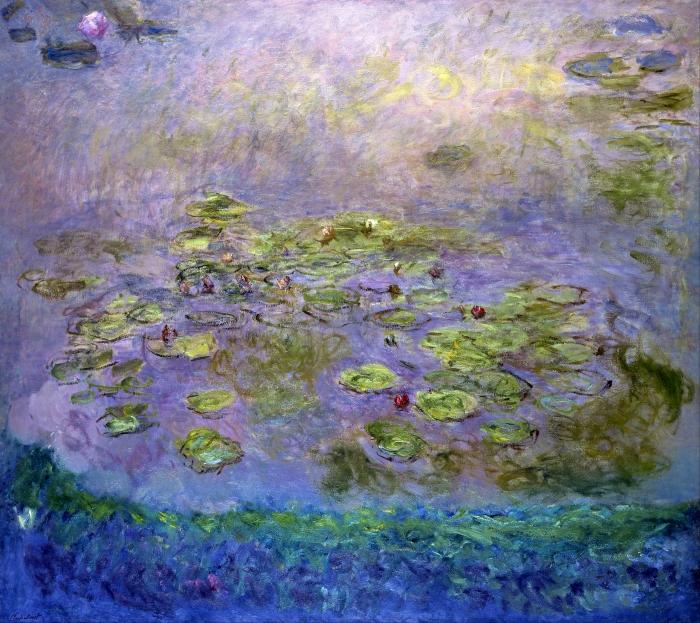The flowers of war

Claude Monet's Nymphéas 1914-17. Image: National Gallery of Australia.
At a small hospital in Giverny, France, soldiers would scream in the middle of the night, believing they were still in the trenches. Doctors and nurses would battle to ease their pain and suffering as they cried out, over and over again, for their mothers. And the artist Claude Monet would bring them vegetables he had grown in his garden to nourish them.
The 74-year-old artist had been working on the creation of his magnificent jardin d'eau, or water garden, when war broke out, and he was acutely aware of the horrors that came with it.
“Yesterday I resumed work,” he wrote on 1 December 1914. “It’s the best way to avoid thinking of these sad times. All the same, I feel ashamed to think about my little researches into form and colour while so many people are suffering and dying for us.”
The peace of his garden was sometimes shattered by the sounds of gunfire from the battlefields only 50 kilometres away. His stepsons were fighting at the front, and his own son Michel was called up in 1915. Many of the residents of Giverny fled to safety, but Monet refused to go, even after his family was evacuated south. “If those savages must kill me, it will be in the middle of my canvases, in front of all my life’s work.”
Monet set about creating the paintings of waterlilies and irises which he grew in his garden, paintings which have since been recognised as among his greatest works.
A constant visitor during this time was Monet’s good friend and confidant, the French Prime Minister Georges Clemenceau, who had a house in a neighbouring village. He would often visit during the war and save the paintings from Monet’s frustrations. Angered by his failing eyesight, Monet would often slash them with a razor or attempt to burn them in the fireplace.
Monet’s works are now the subject of the Flowers of War concert at the National Gallery of Australia on 29 and 30 September. The concert is one of a series of concerts created by the Australian War Memorial’s musical artist in residence, Christopher Latham, to commemorate the centenary of the First World War.
“The First World War was a period of creative impotence as artists struggled to respond to the scale of the horror, but there was one notable exception – Claude Monet,” Latham said.
“Struggling with his ever-diminishing sight, Monet raced to finish his life’s work, creating an extraordinarily vast catalogue of wartime works.”
Between 1914 and his death in 1926, Monet produced just over 200 paintings, many of which he grouped into a series on an immense scale, which he called Les Grands Décorations.
“During this period, Monet was not only working in isolation, bothered by the unusually bitter winters, but also increasingly disturbed by cataracts,” Latham said.
“To slowly lose his great gift plunged Monet into severe anxiety and a sustained period of hyper-creativity, as he struggled to create his final culminating masterpieces – a body of work he hoped would summarise everything he felt and believed about painting. In doing so he created more work than any other artist during the Great War.”
Painting was what Monet did, and he saw it as his patriotic contribution to the war effort. A group of paintings of the weeping willow, a traditional symbol of mourning, was Monet’s most immediate response to the war, and expressed the grief of France for her lost sons.
On 12 November 1918, the day after the Armistice, Monet wrote to Clemenceau, proposing to give his best works from his Grandes Décorations to the nation “to honour the victory and peace”. That gift can now be seen in the Musée de l'Orangerie in Paris, a venue which had been a canteen for wounded soldiers during the war. The donated works filled two rooms with 22 enormous panels – more than 80 square metres of canvas. Images of them will be projected during the concert.
“With images and music, this concert tells of the last flowering of Impressionism and of how the great French outpouring of colour, both in art and music, was then destroyed by the violence of the Great War,” Latham said.
"Monet felt his late paintings were an attempt at healing. They were his artistic response to the traumatic events of the war and arguably the greatest climax to any artist’s creative career in history.”
Monet’s Flowers of War: The Last Shining of the Belle Epoque is on at the James O Fairfax Theatre, National Gallery of Australia, Canberra, on Friday, 29 September 2017, at 7.30pm, and Saturday, 30 September 2017, at 2pm. www.flowersofwar.org
The concert program will be performed by Latham (violin and director), flautist Jane Rutter, cellist David Pereira and pianist Tamara Anna Cislowska. It will feature works by Jean Cras, a career naval officer as well as a composer, Phillippe Gaubert and Maurice Ravel, who served in World War I, and late pieces by Lili Boulanger and Claude Debussy, both of whom died in 1918.